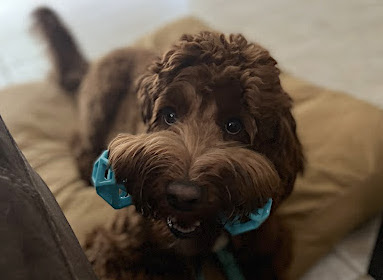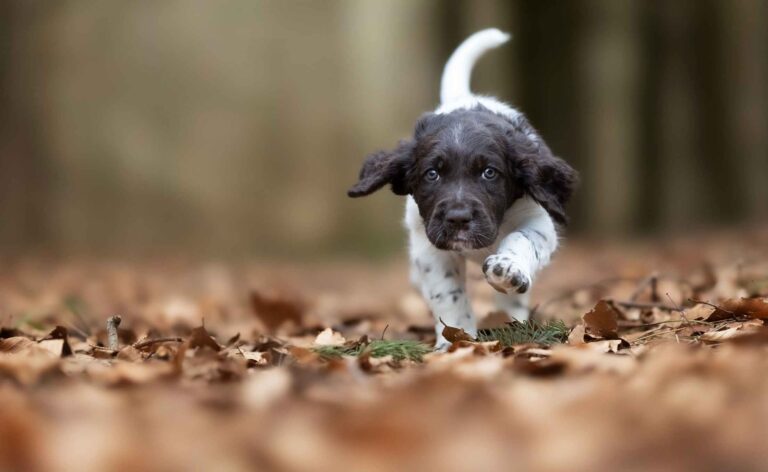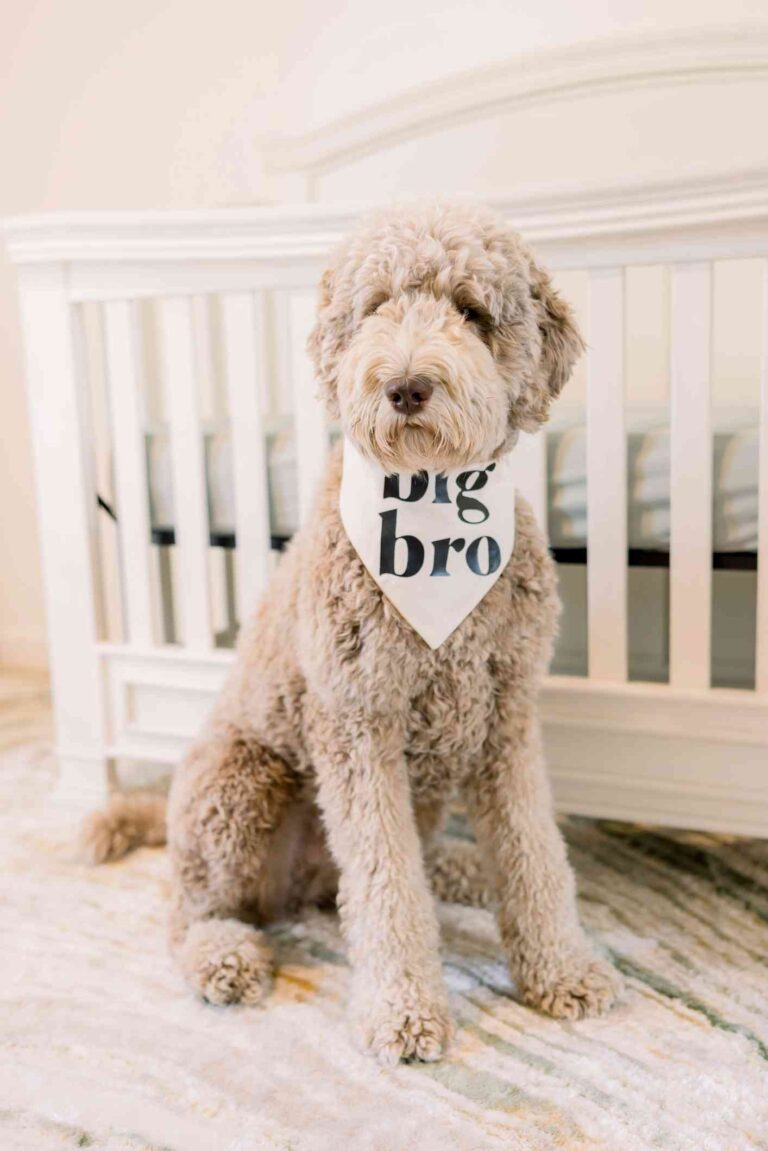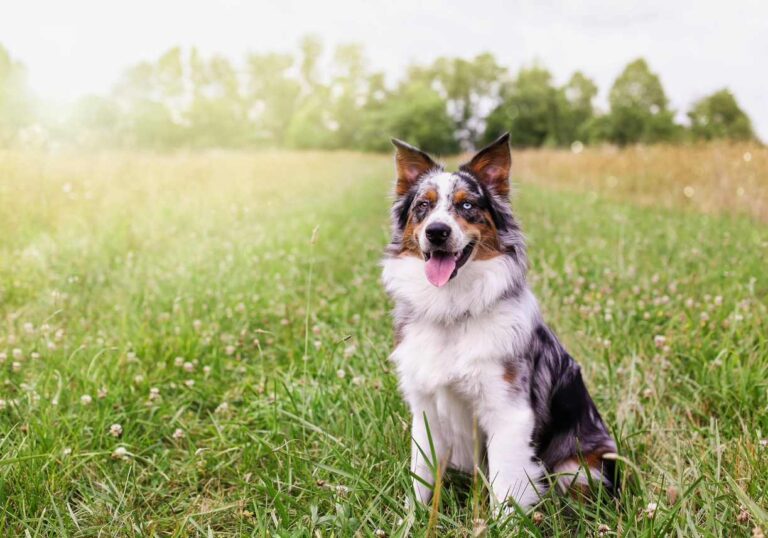Puppy play biting. It’s one of our most asked-about behaviors when bringing a new puppy home. And for a good reason! It doesn’t feel great and is a behavior we see in almost every puppy! This is because play biting is one of the few ways a puppy can communicate at a young age. Between the ages of 3-8 weeks, puppies are still living amongst mom and their littermates. During this critical period, they are learning bite inhibition or self-awareness of how hard is too hard when they bite. Many owners bring their puppies home around 10 weeks of age, which is also the time most of our clients begin to recognize play biting as a problem behavior. Play biting, although typically annoying and a little painful, should not cause enough pressure to break the skin, cause excessive bruising, scratches, or draw blood. If this is occurring, our trainers would label this as a red flag. Play biting that extreme is more likely to occur in puppies taken away from their littermates too early or raised in puppy mills before the age of 8-9 weeks. We will talk about abnormal play biting later on in this blog. Otherwise, you are probably experiencing a very normal, excitable puppy, trying to play with you. We know you love your puppy, maybe you just don’t love what can feel like excessive teeth on you. We totally understand, which is why we are going to explain why play biting can feel like a constant battle and discuss ways our trainers recommend addressing and reducing the likelihood of play biting in the future.
What is play biting?
Play biting is defined as putting their mouth on human skin, or anything attached to a human. This could mean your hands, hair, watches, socks on your feet, etc. Play biting is classified as an attention-maintained behavior. Attention-maintained behaviors are reinforced by gaining access to attention, which means any level of attention, whether you deem it “corrective” or not, could be enough to reinforce the behavior and increase the likelihood that it will occur again in the future. Even a simple “No!” or pushing your puppy away from you can be seen as attention in your puppy’s eyes. To target play biting, our trainers use a few combined strategies which will encourage an alternative appropriate behavior, and discourage play biting itself.
Encourage an alternative behavior to access attention
We recommend starting early in teaching your puppy appropriate or desired behaviors that will give them opportunities to earn attention from you in a way that isn’t jumping, barking, or play biting. Teaching the Auto-sit is a great way to start! In general, we recommend limiting petting your puppy for “free” and looking instead to capture opportunities where they are sitting down, laying down, or chewing on an appropriate toy (Kongs, antlers, cow bones, Nylabones, harder toys). Your puppy will begin to learn that in order to gain access to your attention, there are specific behaviors they can engage in that will elicit that response from you. After a few days, it’s quite common to notice your puppy offering you behaviors you didn’t even ask for just to earn some extra love!
Discouraging play biting
Our owners and founders, Dr. Kristyn Savage, Ph.D., CAAB, BCBA, and Sean Savage, BS, CDBC, CPDT-KA, have developed the following exercise which will help to encourage and reinforce playing with appropriate toys and discourage play biting by not reinforcing any occurrences.
Play biting exercise
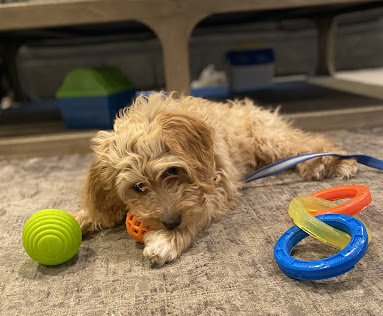
You will need:
- A 6-foot leash
- 6-8 indestructible toys – Nylabones, Kongs, Deer Antlers, Cow Bones
- Avoid toys such as plush, fabric, rope, and rawhide
How to start:
- For the first 3 days, tether your puppy to something stationary.
- Offer your puppy a couple of toys in access.
- Place a toy such as an antler into your hand, and begin encouraging your puppy to put their mouth onto the antler. As soon as their mouth goes onto the antler, immediately praise and begin petting with the opposite hand.
- When your puppy takes their mouth OFF of the antler, immediately stop giving attention. Try to get them interested in putting their mouth back on the antler again. When they do, immediately reinforce with praise and petting.
- If at any point, your puppy puts teeth onto your skin or any part of your body or clothes, regardless of strength or if it was an accident, immediately stop giving attention, pick up all of the toys, and walk out of sight. Remain out of sight for 30 seconds.
- When your puppy is quiet, go back into the room, recreating the same situation that caused them to play bite the first time, and then offer another opportunity to be successful.
We recommend practicing this exercise from Day 1 and practicing daily. If you have children, this is a great way to get them involved and ensure your puppy’s behavior generalizes across everyone in the home. Practice for at least 10 minutes per day.
Management Strategies:
- Your puppy should always have free access to at least 6-8 appropriate toys at all times while out with you.
- Practice during times you know your puppy engages in play biting during the day
- If your puppy is not tethered and play bites you, do not say anything to them. Ignore them completely. After they have stopped engaging in attention-seeking behaviors (jumping, barking, play biting) and offer you something appropriate such as an auto-sit, down, or if you can redirect them to a toy after, deliver immediate praise and attention.
- If you cannot practice the strategies above, use one of the following strategies:
- Tether your puppy out of reach of you with access to appropriate toys.
- Utilize an exercise pen to separate your puppy and give them a “yes” space, offering appropriate toys.
- If you cannot supervise your puppy, place them in their kennel with access to appropriate toys.
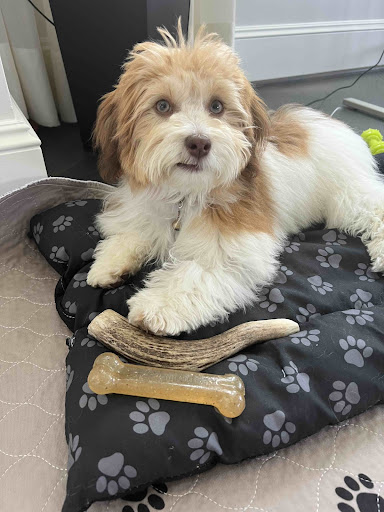
When should I bring in a professional?
Play biting can be a tedious behavior to address because it can feel like a constant occurrence. We would recommend seeking out a professional behavior consultant if you are not seeing a reduction in your puppy’s play biting after introducing these techniques, or if your puppy is engaging in any of the previously listed “red flags” such as excessive bruising, scratching, or bites causing punctures or drawing blood. If play biting is occurring and producing some level of injury at this age, it can be an early indicator of more severe problem behaviors, including aggression. Lack of bite inhibition as your puppy gets older can result in a more serious bite or injury to a person, dog, or another animal. We find that puppies who lack bit inhibition tend to be less sensitive overall to punishment techniques, such as verbal reprimands, which could be challenging in other areas as they get older. For this reason, using positive reinforcement techniques, such as the ones we’ve discussed above, at a young age would be even more crucial in training your puppy. Separately, getting a professional opinion can help in providing additional training strategies, techniques, and peace of mind.
If you are interested in additional information on puppy manners or would like to speak to a professional, please reach out!
